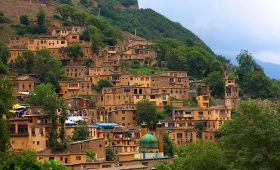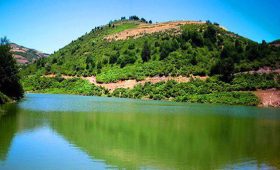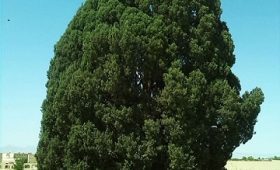Takht Rostam fire temple, Shahryar has an area of 340 square kilometers and is located in the west of Tehran province. According to the existing historical monuments and archeological evidence, the pleasant climate area of Shahryar has a long history and dates back to approximately 6000 or 7000 years before Christ. The name Shahriar means big city or metropolis, and in the past, it was considered one of the administrative regions of Ray.
One of the historical monuments and an indicator of the identity of Shahryar, named Takht Rostam fire temple, is located 20 kilometers southwest of this city, near Qajr Takht Rostam village in Joqin district, on Takht Rostam mountain. This fire temple was a place of worship and various rituals of Zoroastrian monks during the Sassanid period. In this building, remains of a two-story platform can be seen on the top of the hill that was probably used for lighting fires.
In Shahryar, people like Maxim Siro Vidagodar and Andre Godar, who are famous archaeologists, have made important historical discoveries; But in the case of Takht Rostam, an exact date has not been determined for it, because archeological excavations in this area have not been completed, however, the history of the historical site of Takht Rostam Fire Temple is attributed to the Parthian and Sassanid governments.
Takht Rostam fire temple of Shahryar is one of the important fire temples of Tehran province, which was attributed the name of Takht Rostam after the Arab attacks on Iran and Shahryar region. In fact, most of the important places in Iran were changed to Takht Suleiman or Takht Rostam after the Arab invasion and the arrival of Islam.
The cone-shaped mountain on which Takht Rostam was built and is the highest mountain in Shahryar is called Takht Rostam. This mountain is made of volcanic and andesite rocks and Takht Rostam fire temple was built at an altitude of 1318 meters.
In parts of the tip of Takht Rostam and its slopes, architectural works in the form of a throne can be seen using materials such as mortar, stone, and plaster.
This fire temple consists of two platforms, one of which is located at the bottom of the mountain and the other at the top of the mountain. In the part of the first platform, which was built in a freer space, it was the place to light the fire and the second platform was also the place for Zoroastrian religious ceremonies. A dome-shaped structure can be seen in the lower part of the mountain, which was built at a distance of 15 meters from the place of the lower throne, and there is a possibility that this place was used as a fire storage place. The dome-shaped building has a short roof and a height of 238 cm from the floor to the tip of the dome. The architecture of Iran after Islam is evident in this domed structure because two entrances decorated with arches can be seen in it, and it represents the changes of the fire temple and perhaps its change of use after the arrival of Islam in Iran. The middle stone cells of the area, which are circular in shape, were the place to light the sacred fire, and according to the research, the fire was visible from a distance of 150 km at night. According to some sources, there are two hypotheses for the construction of the Takht Rostam building: it is most likely built during the Sassanid era and by the order of Mobad Maziar of Fujiana, and secondly, according to some observations, there is a possibility that it was built during the Parthian era.
Among the remains of Rostam’s throne building, there is a relatively large board that is located at a height of 40 meters from the plain and on the hillside, as well as its porch, room and dome. Takht Rostam fire temple includes three places for maintaining and lighting fire and worshiping worshipers. Today, the place of worship has been destroyed. The second location of the fire temple on the hillside was built in a skillful and mysterious way, which now lacks roof and columns. The third site, which was built on the top of the mountain, was the only entry point for Mobad Arshad, and this part was completely destroyed after the Arab attack and only stone slabs remained. After the Arab invasion, the design and plan of fire temples of the Sassanid period were changed in the form of four porches or two porches, with dome roofs and porticoes and with columns around, and their use was changed to mosques and other religious or historical places.
Shahryar Caravanserai, several historical castles, centuries-old old trees, several ancient hills, Shahryar Gardens, historical cemetery and other works discovered in Shahryar originate from the seven thousand years old history of this area and have become historical and tourist attractions of Shahryar city.




